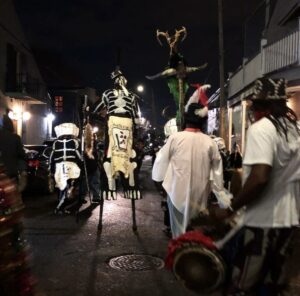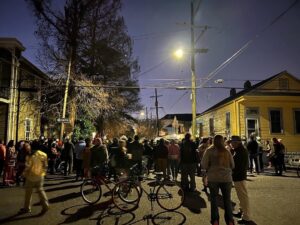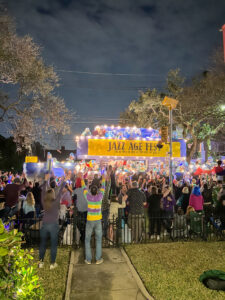
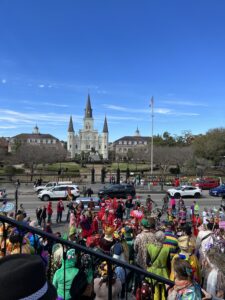
There are more than 70 Mardi Gras parades in New Orleans that span from January 6th all the way until Mardi Gras day (Fat Tuesday), and every local you ask will have a different favorite. When I see “Best Mardi Gras Parade in New Orleans” lists, I’m always perplexed by them. What does the author mean by “best”? Best for whom? Recommending parades is like recommending vacation destinations—it’s not a one-size-fits-all thing.
Here’s the truth that a lot of people won’t tell you. Mardi Gras in New Orleans isn’t for everyone. Many of the festivities are overwhelmingly crowded, raucous, and not family-friendly. If you don’t love a loud party and objects being thrown at your head, there are parades that you simply will not like. BUT the magical thing about Mardi Gras that a lot of tourists don’t see is that you can tailor it to your own personality and energy level. The super krewes (largest and glossiest) parades get the most publicity and make all the “best of” lists, but there are plenty of smaller parades for those interested in an alternative.
I grew up in Mississippi just over an hour from New Orleans, so I’ve always been familiar with parade culture. I always got a full week off school for Mardi Gras (just like every school in the region), and I grew up going to the small parades in and around my hometown. And until middle school, my family went to a large parade in Metairie (New Orleans’ neighboring parish) because it was supposedly more family-friendly than parades in the city. It got a bit more rowdy every year though, and my parents finally decided they didn’t feel comfortable bringing me and my sister anymore.

This is my 7th Mardi Gras season living in New Orleans, and now I have a different perspective of the season. (I wish I could go back and tell my parents which parades to go to for an entirely different experience!)
As a person who hates large crowds, flinches at loud noises, and is disinterested in party culture as a whole, people might assume that Mardi Gras just isn’t for me. But thankfully I’ve lived inside the parade “box” for all my years in the city, so it’s been easy for me to sample the majority of those 70+ parades and find the ones that I love. (At a quick glance, I think I’ve been to around 40 of them.)
This is not a best-of list, because what’s best for me might not be what’s best for you. But if you’re a person looking for some alternatives to the parades that most tourist-targeted lists will give you, this might help.
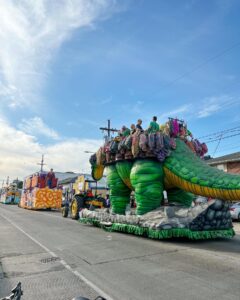
My Favorite Mardi Gras Parades in New Orleans
(In order of my favorites, though I keep changing my mind)
A quick note on lingo – a “krewe” is the social organization that stages a parade. In other words, the parade’s riders or walker/facilitators—the people in the thing. A lot of visitors assume this is a cutesy nickname. But no, this is the official term, and often being in a krewe is a BIG DEAL that requires large membership fees, special referrals to be accepted, and sometimes years-long waitlists. Or sometimes it cheap and easy to join—it depends on the krewe.
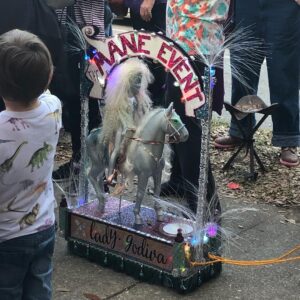
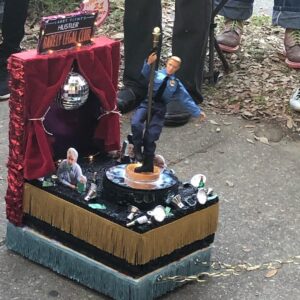
10. ‘tit Rex
‘tit Rex was born as a direct response to New Orleans’ super krewes (the largest and most elaborate parades). As the parades got bigger and bigger in all regards (scale, crowd size, throw size, cost), the founders of ‘tit Rex decided to take the opposite approach. They created what is supposedly the world’s first microkrewe where all the floats are required to have a shoebox base. But just because they’re physically small doesn’t mean they are any less elaborate than the giant floats. In fact, I think their intricacy makes them even more impressive.
The ‘tit Rex route isn’t long, and viewers crowd the sidewalk to watch the tiny spectacle go by. There are a lot of kids, a lot of families, a lot of enthusiastic nerds (which, to be clear, includes me), and a generally good-spirited audience that doesn’t need a raucous party to have a good time.
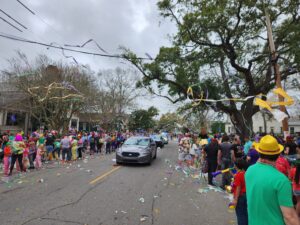
9. Krewe of Red Beans
The Krewe of Red Beans is a walking parade where riders wear handmade costumes decorated with a New Orleans culinary staple—red beans. The parade takes place on Lundi Gras, the day before Fat Tuesday, because Monday is the traditional day when residents cook red beans and rice. This is a welcoming krewe that anyone can join for a (relatively) small fee, and they do a lot of fundraising for good causes and community initiatives. There’s also now a spin-off krewe—the Krewe of Dead Beans—which marches in a nearby neighborhood before joining the Red Beans group.
As with many seemingly absurd events in New Orleans, this is an event where locals can show off their stunning creativity. You can’t imagine how elaborate art and fashion made of dried beans can be.
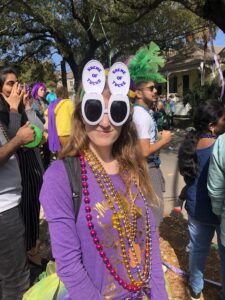
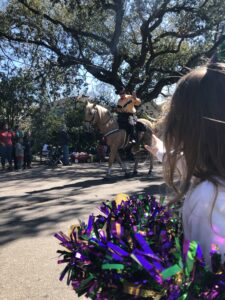
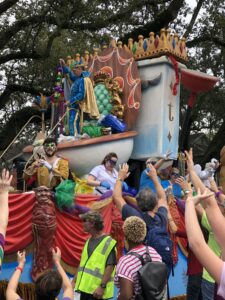
8. Tucks
The Krewe of Tucks stands out because of its humor. A lot of the daytime Uptown parades blur together for me, but Tucks distinguishes itself by not taking itself too seriously. The king rides on a famous toilet float, and the prized throws are decorated toilet brushes and plungers. (I have one that I’m very proud of.) There’s a lot of toilet humor, and a lot of toilet paper, and a lot of general silliness. But they do a good job of brushing against the vaguely risqué while still being family-friendly.

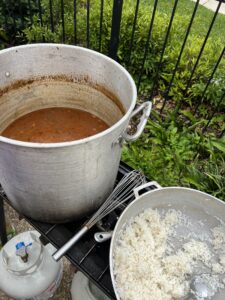
7. The Uptown Parades 2 Saturdays before Fat Tuesday
Rather than a specific parade, I’m just recommending this entire day. Two Saturdays before Mardi Gras is always a wonderful time to be in Uptown New Orleans. (To be clear, this is not the Saturday closest to Mardi Gras but the one before that.) This day is great because the tourists haven’t arrived for the following week’s biggest parades, so the crowds are smaller and mostly local families. So many Uptown families have traditions on this day like crawfish boils and king cake parties, and everyone is settling into the spirit of the season.
To be honest, the parades that roll this day all blur together for me—there are usually 6 of them back-to-back from morning until dark. But when the weather is good, you can be out on the route, riding a bike, running into pals, and people watching all day. If you want to bring your family to experience Mardi Gras for the first time, this is the day I’d recommend, and this is the crowd that I wish every parade day could have.
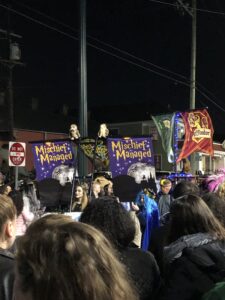
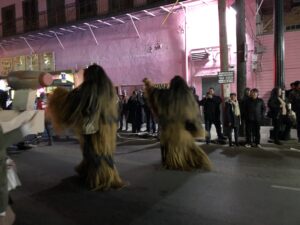
6. Chewbacchus
Chewbacchus (formally called The Intergalactic Krewe of Chewbacchus) is another walking parade that celebrates nerdom in the most enthusiastic way possible. In their own words (from their website), they are an “organization for revelrous Star Wars freaks, Trekkies, Whovians, mega-geeks, gamers, cosplayers, circuit benders, cryptozoologists, UFO conspiracy theorists, mad scientists, and all super nerds,” but this expanded to include really every nerdy fandom you can imagine. There’s a lot of Harry Potter. There are a lot of comics. Every sci-fi and fantasy story you can imagine is here, and this parade is HUGE. It’s one of the earliest parades of the season, so it’s usually a little cold, people are excited for the first big parade, and there’s really no better way to begin the Carnival season. No one is having more fun than these friends.
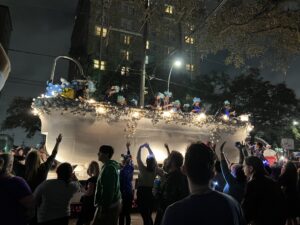
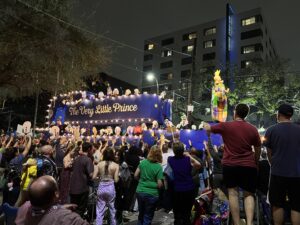
5. Muses
The Krewe of Muses is the largest float parade on this list, and the one I can nearly guarantee will be on every “best parade” list you read. And in this case, I agree with the masses. It rolls the Thursday night before Mardi Gras, and for a lot of people, this parade is the big one that kicks off the week of non-stop parading.
Muses is an all-female krewe with clever themes and some of the most beautiful floats you’ll see. Their signature throws are decorated shoes which are one of the most sought-after throws of the entire Carnival season. Rarely are shoes thrown randomly—they are usually handed directly to select people in the crowd. I am still awaiting the day that I might receive one.
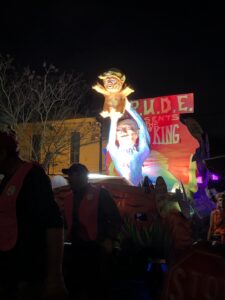
4. Krewe du Vieux
The walking parade Krewe du Vieux is the most irreverent, vulgar, and brilliant parade of Carnival season. If you feel disillusioned with society (whether on a local level or global level), the scathing geniuses of Krewe du Vieux will be there to assure you that you are not alone. And they’ll make you gawk, blush, and laugh until your face hurts in the process.
This isn’t a family-friendly parade, but it’s sure to bring you joy. Though be warned that if you are easily offended or a big fan of our current government administration, this is probably not the place for you. Since Krewe du Vieux is early in the season, few tourists have arrived yet, so the krewe knows they are in like-minded company and safe to share their boldest opinions. No political figure is safe. I’ve also been to the Krewe du Vieux after party—these people are shameless and wild in the most New Orleans way possible.
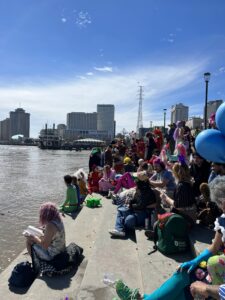
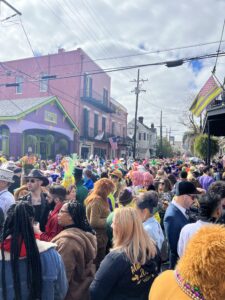

3. St. Anne
On Mardi Gras day, The Krewe of St. Anne (or the Société de Saint Anne) gathers at a loosely defined corner in the Bywater neighborhood to start slowly making their way to the French Quarter. While the tourists crowd St. Charles Avenue for the chaos of the Rex and Zulu parades, St. Anne is where you’ll find the truest spirit of Mardi Gras.
St. Anne is very different than other parades because anyone is welcome to join. You can hop in at any point. The path is not very direct, and people peel off for various celebrations on the way, but most of the crowd is heading toward the river. For the past 30 years, St. Anne marchers have been known for their tradition of scattering the ashes of loved ones who’d died in the previous year in the river. Nearly everyone in New Orleans knows someone who has spread a loved one’s ashes in the Mississippi River on Mardi Gras day. (It’s where I brought the ashes of Harry and Pudge, two of my beloved dogs.)
To people who aren’t from New Orleans, this might sound morbid, but it’s the opposite. St. Anne is a celebration of everything Mardi Gras stands for. It’s a last hurrah of the Carnival season where locals display their absolute peak creativity. If you’re a tourist visiting New Orleans on Mardi Gras day, forget the big floats. St. Anne is unlike anything else you’ll ever see. (Here’s a wonderful article about it.)
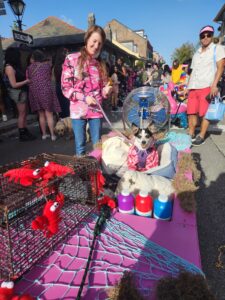
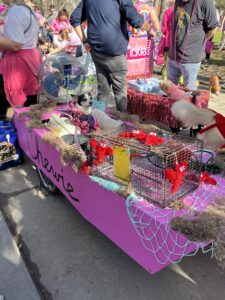
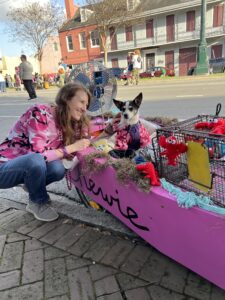
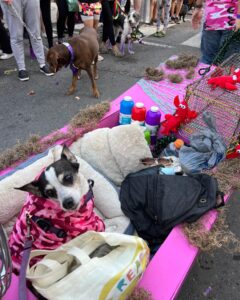

1. (A 1st place tie) The Mystic Krewe of Barkus
If you know me at all, this will come as no surprise. My favorite of all the parades, and the only organized parade I’ve been in myself, is Barkus—the dog parade. They call it the dog parade, but really all animals are welcome. I’ve seen cats, pigs, and other friends join, too. The krewe marches through the French Quarter eliciting boundless adoration and joy.
The parade has a different theme each year, and pet owners decorate special floats, wagons, and costumes for their pets. There’s dog royalty, endless treats, and lots of local rescue organizations showing off their adoptable dogs. It’s a parade for pet lovers of all ages and their pet friends, and there is no other Mardi Gras parade that consistently delights me more. And this is not a small, side thought of a parade—this is one of the biggest and most popular parades of the weekend. Last year, my elderly Chewie thought the entire crowd was there for her, and who’s to say they weren’t?


1. (A 1st place tie) The Northside Skull and Bone Gang
Tied for my number 1 favorite Mardi Gras tradition is the mysterious Northside Skull and Bone Gang. Each Mardi Gras day for the past 200 years, the skeleton group gathers in the Treme before the sun rises. These aren’t cute and funny skeletons—their costumes are large and menacing, complete with antlers, staffs, and huge paper mâché skulls. By 5:30am, they’re knocking on doors in the neighborhood, waking up strangers to declare, “You’re next!” The Northside Skull and Bone Gang represents the literal meaning of carnival as a shedding of the flesh and death as a great equalizer. It’s part celebration and part warning—you better live right because you only have right now.
It’s not a parade in the traditional sense, but a crowd gathers at 5:00am to watch them wake up the neighborhood. Their traditions are rooted in African spirituality, and they dance and chant to drum beats as they march through the streets. Some onlookers have just rolled out of bed to see this, and others stayed awake all night. It is worth whatever lack of sleep necessitates you seeing this at least once.
I like this crowd more than the parade crowds. The tone is different here—there’s something like reverence as the city starts to wake up on its most important day of the year. This is a version of Mardi Gras that most tourists don’t see. Watching the bone-men dance in the dark Treme streets on Mardi Gras mornings feels so distinctly and powerfully New Orleans that nothing could feel exactly like this anywhere else on Earth.
